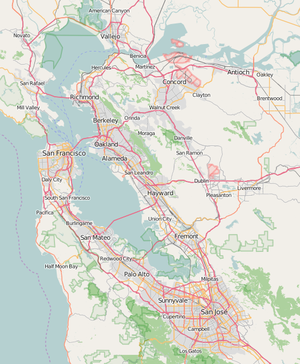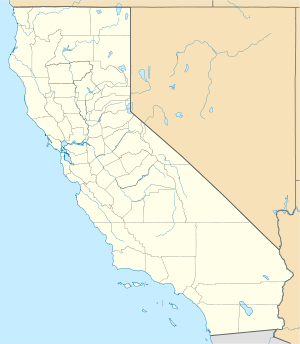Marin Islands
This article includes a list of general references, but it lacks sufficient corresponding inline citations. (September 2013) |
| Marin Islands National Wildlife Refuge | |
|---|---|
IUCN category IV (habitat/species management area) | |
 View of both Marin Islands, from the East Peak of Mount Tamalpais. | |
| Location | San Pablo Bay, Marin County, California, U.S. |
| Nearest city | San Rafael, California |
| Coordinates | 37°57′55″N 122°28′16″W / 37.96514°N 122.47116°W[1] |
| Established | 1992 |
| Governing body | U.S. Fish and Wildlife Service |
| Website | Marin Islands National Wildlife Refuge |

The Marin Islands are two small islands, named East Marin and West Marin, in San Rafael Bay, an embayment of San Pablo Bay in Marin County, California.
Geography
The Marin Islands are located offshore from the
History
The islands are named after the
The islands were donated to the federal government by the Crowley family of San Francisco. They had been bought by Thomas Crowley at auction in 1926 for $25,000 in the hope that they would become the western terminus of the Richmond–San Rafael Bridge. Instead, they became a family vacation spot for more than sixty years.
Ecology
West Marin Island, elevation 26 meters (85 ft) above the bay waters, supports the largest heron and egret rookery in the San Francisco Bay Area. Nesting species include great egrets, snowy egrets, great blue herons, and black-crowned night herons.
East Marin Island, a former vacation retreat, now supports a variety of introduced and native plants and provides critical nesting material and rest sites for the nearby colony.
The submerged tidelands support a variety of resident and
See also
- Islands of San Francisco Bay
- San Pablo Bay topics

References
- Martin, James A.; Lee, Michael T. (2006). The Islands of San Francisco Bay. San Rafael, CA: Down Window Press. ISBN 0-9787241-0-0.
- Fish and Wildlife Service (3 March 2009). "Marin Islands NWR". U.S. Department of the Interior. Retrieved 2009-09-05.
- Refuge profile
- Refuge website
![]() This article incorporates public domain material from websites or documents of the United States Fish and Wildlife Service.
This article incorporates public domain material from websites or documents of the United States Fish and Wildlife Service.




